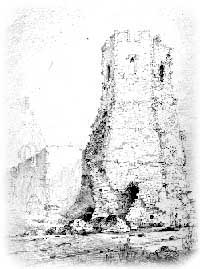Roman Pharos Prints

The Roman Dubris (Dover) with its two lighthouses

On Dover Heights by Thomas Hastings
The two pictures show very different views of the Roman lighthouse, or Pharos at Dover. The left picture is an 18th century rendition of how Dover would have perhaps looked during Roman times, showing both lighthouses and the fort in the valley. The right hand picture is a romantic view of the remaining Pharos in a ruinous state.
The Roman Dubris (Dover) with its two lighthouses. From an old print.
This print, from around 1730, has been adapted from one originally drawn by the noted 18th century antiquarian William Stukeley, and gives that artist's impression of Roman Dover. Particularly noticeable are the 2 lighthouses (one of which still stands at Dover Castle, the foundations of the other being visible at the Drop Redoubt) and the fort of the Classis Britannica on the slope of the Western Heights.
On Dover Heights
T. Hastings, pencil sketch, 17th July 1824
This sketch shows a detailed view of the Pharos (Roman lighthouse) with part of the then ruinous
Church of St. Mary-in-Castro visible in the background at left.
Thomas Hastings (fl. 1813-1831) was a well-regarded amateur etcher and was published. Beyond this, little is known of him.
This sketch shows clearly the division between the original roman sections (at the base) and the later medieval additions, including a crenellated roofline.
The Pharos (Eastern Pharos)
Dover's Eastern Pharos stands to a height of 13 metres within the grounds of Dover castle. A twin tower originally stood on the Western Heights. The two lighthouses were probably built to mark the entrance into Roman Dover, then known as Dubris. The towers were octagonal in plan, with the floors stepped in towards the top. Both tiles and brick were used in the construction. Fires were lit on the top stage to give a clear guide to ships crossing the channel.
A third tower was built at Boulogne by the emperor Caligula to guide ships into that harbour. During the medieval perios the Pharos was used as a bell tower for the adjacent Saxon church.
The Pharos which stands adjacent to St Mary's in Castro was one of two lighthouses built to guide the Roman fleet of the Classis Britannica into the harbour. The one on the western side of the valley survives only at the level of it's foundations. The Pharos within the castle grounds survives to a height of about thirteen metres which makes it the tallest surviving Roman building in Britain. Externally the tower was octagonal in plan but internally square. It's overall width is approximately twelve metres, and it may once have stood to a height of twenty-four metres comprising eight stages. Each stage stepped in about thirty centimetres to give the structure a telescopic appearance in elevation.
It is constructed from flint rubble bonded with double courses of tiles at regular intervals and faced with tufa ashlar. The windows and doors are arched and are decorated by the alternate use of tufa and tile to achieve a polychrome effect. The tiles are of the same pinkish material found in the fort of the Classis Britannica and it seems reasonable to suppose that they were built at broadly similar dates. The dating of the early phase of the fort is around AD130 to AD150.
As it stands today only the first four Roman stages survive, albeit in a weathered and in part refaced state. The remaining 5.8 metres was used as a medieval belfry. The earliest reference to the bells appears in 1252, when three bells were cast in Canterbury to be hung in the tower. In 1345 £15 18s. 5¼d. was spent on two new bells weighing 4266 lb and 1078 lb respectively. The medieval stage appears to have been rebuilt between 1426 and 1437 when four masons are listed as being engaged in setting up in the belfry five new stone windows brought from Folkestone. This work involved the expenditure of the majority of the £176 11s. 11½d which appeared as repairs in the accounts submitted for the period.
As part of a comprehensive restoration programme begun in 1580, the Pharos was given a new floor and roof in 1582. This work was done to enable the Pharos to be used as a powder magazine.
In 1724 William Stukeley wrote that the tower had a pleasant ring of bells, but that these had lately been carried off to Portsmouth by Sir George Rooke (died 1709). He further writes that since that time the Ordnance Office had removed the lead from the roof. It is unclear whether Stukeley means the Pharos tower but it is likely that he does.
The Fort of the Classis Britannica
The Roman fleet in Britain was called the Classis Britannica. Around AD117 the fleet began building a fort at Dover. This fort was probably never finished although the remains of a fort wall and three barrack blocks were discovered during rescue archaeology by the Kent Archaeological Rescue Unit beginning in 1970. A second fort on the same site replaced this earlier building from AD130-140 and this was occupied until AD155.
The fort seems then to have been abandoned and the next period of occupation appears to have been from AD190 to AD208, after which it was allowed to decay. By AD270 many of the buildings had collapsed and were covered with soil. It has been suggested that these periods of abandonment may be as a result of the fleet being away campaigning